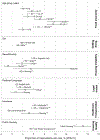Social Risks Among Primary Care Patients in a Large Urban Health System
- PMID: 32199514
- PMCID: PMC7362999
- DOI: 10.1016/j.amepre.2019.11.011
Social Risks Among Primary Care Patients in a Large Urban Health System
Abstract
Introduction: Health systems are increasingly interested in addressing the social determinants of health via social risk screening. The objective of this study is to understand the variability in the number and types of social risks overall and in population subgroups among primary care patients routinely screened in a large urban health system.
Methods: Between April and December 2018, a total of 24,633 primary care patients completed a 10-item screener across 19 ambulatory sites within a health system in the Bronx, NY. The prevalence of any social risk and specific social risks was estimated overall and for population subgroups. Wald tests were used to determine statistically significant differences by subgroup. Data were analyzed in winter/spring 2019.
Results: Twenty percent of patients presented with at least 1 social risk. The most frequently reported risks included housing quality (6.5%) and food insecurity (6.1%). Middle-aged (30-59 years) respondents (24.7%, 95% CI=23.6%, 25.7%) compared with those aged 18-29 years (17.7%, 95% CI=16.4%, 19.2%, p<0.001), and Medicaid patients (24.8%, 95% CI=24.0%, 25.5%) compared with commercially insured patients (11.8%, 95% CI=11.1%, 12.5%, p<0.001), were more likely to report social risks. The strongest predictor of housing quality risk was residing in public housing (15.1%, 95% CI=13.8%, 16.6%) compared with those not in public housing (5.6%, 95% CI=5.3%, 5.9%, p<0.001). Housing quality was the most frequently reported risk for children (aged <18 years) and older adults (aged ≥70 years), whereas, for middle-aged respondents (30-69 years), it was food insecurity.
Conclusions: There are important differences in the prevalence of overall and individual social risks by subgroup. These findings should be considered to inform clinical care and social risk screening and interventions.
Copyright © 2020. Published by Elsevier Inc.
Figures

References
-
- CDC. Social determinants of health: know what affects health. www.cdc.gov/socialdeterminants/index.htm Updated January 29, 2018. Accessed May 19, 2019.
-
- Castrucci B, Auerbach J. Meeting individual social needs falls short of addressing social determinants of health. Health Affairs Blog.. www.healthaffairs.org/do/10.1377/hblog20190115.234942/full/. Published January 2019. Accessed September 10, 2019. - DOI
Publication types
MeSH terms
Grants and funding
LinkOut - more resources
Full Text Sources
Miscellaneous

